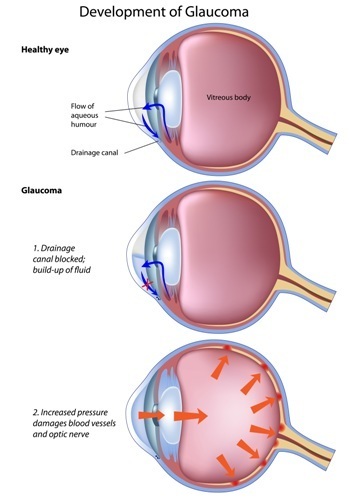Posted by: Georgia Eye Physicians and Surgeons in Latest News
There are many different conditions and diseases that can adversely affect your eyesight, but one of the most serious is glaucoma, which is second only to cataracts as a leading cause of permanent vision loss worldwide. Unfortunately, according to the Eye Diseases Prevalence Research Group, more than three million Americans are currently suffering from glaucoma, but only about half of them are aware of it. This is due, in part, to the fact that many people still have misconceptions about this potentially sight-robbing condition. At Georgia Eye Physicians and Surgeons, Dr. William Segal and Dr. Marc Lay have always been dedicated to providing our patients with the most up to date information available, so here are some important facts that you need to know about glaucoma.

Primary “open-angle” glaucoma, the most common form of the condition, occurs when the aqueous humor (the fluid that fills the space in the front of the eye between the lens and the cornea) fails to drain properly due to a minor defect in the structure of the eye. This causes the intraocular pressure to build to the point when it damages the ocular nerve. A much rarer form of the condition, called angle-closure glaucoma, results when the drainage angle of the eye narrows and becomes completely blocked. This causes the pressure to build quickly, resulting in rainbow haloes around lights, severe eye pain, blurred vision, headache, nausea, and vomiting. There are also forms of glaucoma that have nothing to do with increased eye pressure at all, where the optic nerve suffers damage (with the resulting visual field loss) even though normal eye pressures are maintained. Finally, there are also forms that can result from external eye injury, high blood pressure, or untreated diabetes. There are many different treatment options for glaucoma, but we can diagnose the specific type of glaucoma involved and recommend a treatment that is appropriate for you.
Damage from Glaucoma usually progresses slowly and may not be noticeable at first.
In the initial stages, glaucoma causes no pain or discomfort and affects only the peripheral or side vision. If left untreated, patients may start to miss objects to the side and out of the corner of their eye, but will tend to unconsciously turn their head slightly in order to compensate. This loss of vision gradually progresses until it seems as though the patient is looking through a tunnel, but by that time damage to the ocular nerve has already occurred. Eventually, straight-ahead (central) vision may decrease until no vision remains, but on average this process may take up to fifteen years, depending on the severity of the condition and the individual characteristics of the patient. Because glaucoma symptoms will often go unnoticed, it is important to undergo comprehensive medical eye examinations every one to two years, as recommended by the American Academy of Ophthalmology.
Glaucoma does not affect all patients in the same way.
Although the different forms of glaucoma can potentially affect patients of any age or ethnicity, certain groups are at increased risk. Specifically, individuals over the age of sixty, African Americans over the age of forty, and anyone with a family history of glaucoma can be up to six times more likely to develop the condition. Moreover, not every person with increased eye pressure will necessarily be affected by glaucoma. Some people can tolerate higher levels of eye pressure better than others, so a certain level of eye pressure may be high for one person but normal for another. Other risk factors include thinness of the cornea and abnormal optic nerve anatomy, both of which can be detected through a routine eye exam. In some cases, prescription medications in the form of eye-drops may be able to help reduce the risk of developing glaucoma by about half for patients with these high-risk factors.
Although there is currently no cure for glaucoma, early detection and treatment can significantly reduce the chances of permanent eye damage. At Georgia Eye, we offer several state of the art treatments for glaucoma, including our in-office SLT laser, the outpatient Iridex CYCLO G6™ Glaucoma Laser System, and our newly developed topical drops. Both of the laser treatments require little or no downtime, can be repeated, have virtually no risk of infection, and are usually covered by most health insurance plans. If you have other questions about glaucoma, or would like to learn more about the available treatment options, please feel free to contact Georgia Eye Physicians and Surgeons to schedule an appointment. Follow us on Facebook, Twitter, and Google+ for the latest information about how to keep your vision healthy.

